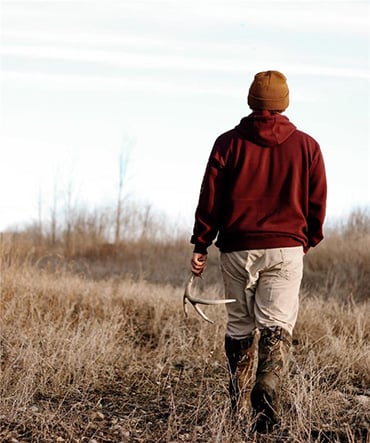Spring will soon arrive, and if you’re a deer hunter (and even if you’re not), it’s a great time to try shed hunt-ing. Each winter after all the whitetail bucks drop their antlers, those beautiful works of nature’s art lie on the floor of forests and fields just waiting to be found. And like fruit dropping from trees, if you don’t find a shed antler in the spring, it won’t be long before mice, squirrels and other rodents begin to chew away at them for nutrition they provide.
Shed hunting can be as intense or relaxed as you want. It’s a great time to head out with your kids and the family dog, but some hunters go on a mission to find a particular buck’s sheds and spend hours hiking hill and dale in search of a particular buck’s rack. There is no one set right approach — except to have fun!
Deer hunters can learn a lot about a buck based on where they find its sheds. Granted, you likely won’t find the buck next summer where you found its shed antler in the winter, but the shed tells you more about where the deer is hiding when hunting pressure and weather become more intense.
For that reason and others, shed hunting has become very popular in the off season. If you’ve never tried it before, keep reading for some insight, and maybe you’ll find yourself scouring the woods.
What is Shed Hunting?
Let’s start with the very basics. The definition of shed hunting is to search for antlers that have been naturally shed by any antler-bearing mammal such as white-tailed deer. A little fun fact for the day, did you know that antlers are the fastest growing bone, according to scientists?
When is shed season?
Bucks begin to shed antlers around February and March in most areas. Shed antlers are a hot commodity for outdoor enthusiasts and hunters, but in areas of extreme winters, it’s important not to stress deer by invading their winter hideouts too soon in the spring.
While bucks no longer need their rack as the season shifts, hunters can use shed antlers help formulate a hunting strategy for the next season and acquire valuable information about a buck’s behavior and moving patterns, at least during late winter.
It’s all about purpose.
To me, antlers on a whitetail buck are the most fascinating thing. I think anyone who has ever seen an impres-sive antlered buck can relate.
Before we take a look at why bucks shed their antlers, we first need to dig into why grow them to begin with. Research by North Carolina Wildlife Resources Commission found that antler growth occurs from late spring through summer. A deer’s body is programmed to pull minerals out of its skeleton to be used for antler devel-opment, meaning that every summer a buck is in a temporary state of osteoporosis. This happens because a deer cannot absorb minerals fast enough through its digestive system to supply the needs of antler growth.
This issue brings forth the question of whether it is helpful to try to enhance your local bucks’ diet with miner-al supplements. Although scientific opinions vary, the consensus seems to be that while putting out minerals could theoretically help a buck produce more antler, it would be nearly impossible for a hunter to put out enough mineral over a wide enough area to supply a particular buck with enough mineral to make a noticea-ble difference.
On the other hand, mineral sites make great trail camera locations and can be yet another piece of the scout-ing puzzle that goes hand in hand with shed hunting.
So, why bucks shed their antlers?
After breeding season (AKA the most wonderful time of the year, the rut) a buck’s testosterone levels drop, stimulating cells in the antlers to break down the tissue between the burr (base of antler) and pedicle (antler growth plates). Eventually, the antler drops off, or sheds, from its own weight. Both antlers may shed at the same time or at different times separated by days or weeks. After the antlers have been shed in late winter or early spring, new growth begins immediately in preparation for the next breeding season or rut.
When, where, and how?
As hunters, it’s important to focus on areas where deer travel to frequently. This could be in bedding areas, feeding areas or travel corridors. Through scouting, you can locate these hotspots and be on track to pick up the majority of the antlers on a property.
Looking for antlers in bedding areas is best done late in the day when deer vacate known bedding cover to vis-it food sources. Follow trails into thick cover and constantly scan for beds and areas deer seek for refuge from winter weather.
Fence crossings can make excellent spots to find sheds since the impact of a jump can cause a loose antler to fall, but a majority of sheds will be found where a buck spends a majority of its time. Buckmasters does not recommend antler traps — various devices installed around feed stations designed to snag antlers and pull them off if they’re loose. Antlers can be quite secure right up until they’re ready to shed, and a buck doesn’t need any extra stress at that time of year, so we recommend allowing nature to take its course and allow ant-lers to shed naturally.
Remember, practice makes perfect. Over time you’ll develop the ability to pick out the general shape and color of an antler, even from a distance. So get outside, look for those sheds, and have a blast doing it.




.png)